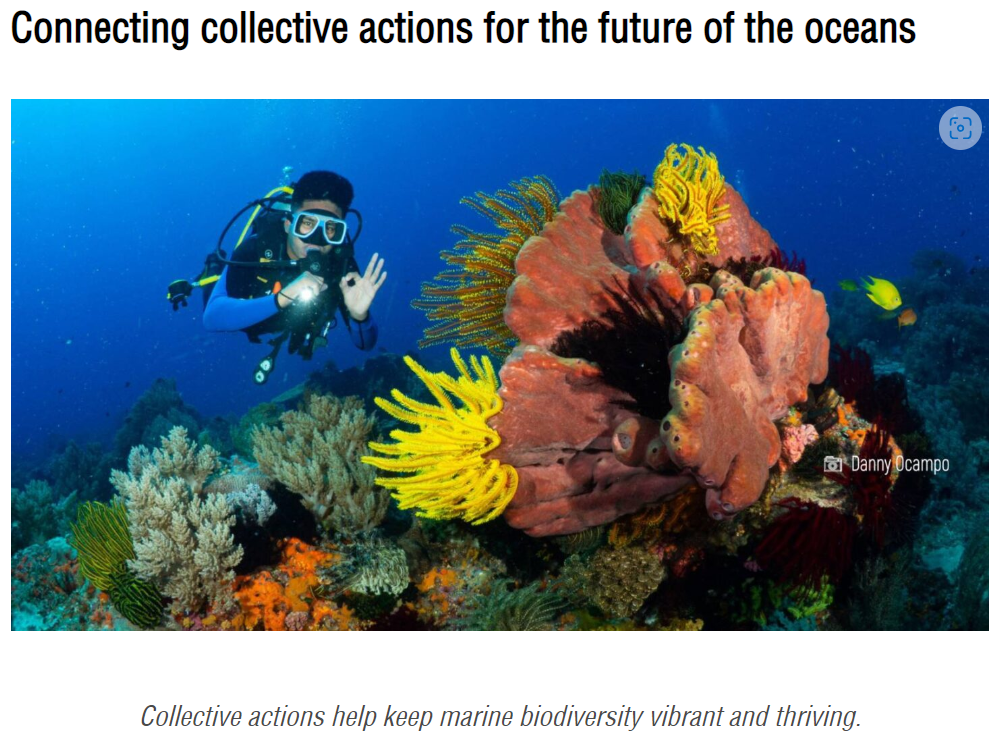Connecting collective actions for the future of the oceans

Oceans and seas may physically divide the Earth’s land mass, but these bodies of water actually connect our lives, our biodiversity, and our natural heritage.
Consider the humble larvae: it may be miniscule in size but their dispersal and migration patterns are huge indicators of the health of marine ecosystems. According to Dr. Theresa Mundita Lim, Executive Director of the ASEAN Centre for Biodiversity (ACB), healthy marine ecosystems are an assurance that there is a consistent supply of larva of many species of fish and invertebrates. Coral and fish larvae can be brought to far distances by ocean currents, demonstrating the ecological connectivity of habitats in every marine ecosystem in the planet. Larval migration pattern also helps to pinpoint important areas that must be protected to ensure the survival of fish and invertebrates, and thus, the productivity of coastal and marine ecosystems.
Unfortunately, the marine biodiversity in the oceans and seas is declining at an alarming rate, said Dr. Lim. Ninety-five per cent of reefs are threatened; while hard coral cover on reefs are declining at an average rate of two per cent per year since the 1980s. This trend indicates that conservation and revitalisation needs to be done in ensuring the sustainable use of marine ecosystems, considering its fragile state and the benefits we derive from its management.
![]()
Facilitating the connection and cooperation among the 10 ASEAN Member States is among the main thrust of the ACB, the region’s centre of excellence for biodiversity. For 16 years, the organisation has been pooling and providing support for the conservation actions in the AMS, often in the form of capacity enhancement, experiential learning programmes, livelihood support and communication, education and public awareness activities.
One of the recent efforts undertaken by the ACB in cooperation with the AMS was the consultation on the development of a regional science-based decision support system. By determining the conditions, needs, and challenges in biodiversity information of the AMS, the ACB hopes to help harmonise access to biodiversity data through a cooperative and well-coordinated intergovernmental approach.
“Addressing the challenge of marine biodiversity loss would require better implementation and operationalisation of environmental policies, regulation, and enforcement,” said Dr. Lim. “The response should be reinforced with apt institutional and technical capacity as well as ardent coordination and strong community support and involvement.”
“Decision-making for conservation and management actions will be made more effective if key stakeholders are informed by accurate, reliable, and timely scientific information.”
![]()
A series of online surveys, national consultations, and regional discussions led by the ACB in collaboration with the Government of Norway through the project Mobilising Stakeholders to Inform the Development of a Science-based Decision Support System for Coastal Wetlands in the ASEAN Region which commenced late last year underscored the importance of establishing an information support system that will cater to the wide range of needs of the different stakeholders.
Discussions around the information requirements highlighted that government institutions are more inclined to use the data for planning, decision-making, and reporting. Research centres and the academe, on the other hand, emphasised the use of data for research, education, and the monitoring physical conditions of ecosystems. For NGOs and other sectors, these valuable knowledge are used for evaluating and monitoring initiatives.
“The ways forward for ASEAN biodiversity should be four-pronged, with the involvement of policymakers, corporate sectors, conservationists, and the general public.” Mr. Christian Elloran, Data Specialist for the Biodiversity Information Management, said as he emphasised the role of effective data management, understanding how to bridge gaps, and implementing best practices in managing data as keys toward the efficiency of knowledge platforms such as the ASEAN Biodiversity Dashboard, ASEAN Clearing-House Mechanism and the ASEAN Biodiversity Outlook.
Strengthened participation from various sectors can help ensure that biodiversity information databases are interoperable, accessible, understandable, and reliable.
![]()
With the theme Revitalization: Collective Action for the Ocean, the World Ocean Day celebration highlights the importance of cross-sectoral collaboration and synergies to enable more powerful and near-real time biodiversity target tracking. Fostering cooperation can help better identify and address critical emerging issues facing coastal and marine biodiversity in the ASEAN region.
“Indeed, just as our oceans and seas are interconnected, so must our actions be, to make the necessary transformation to a better and more resilient ASEAN,” Dr Lim said. “May we also take inspiration from this year’s ASEAN Summit theme, ASEAN ACT: Addressing Challenges Together, as we enhance our efforts in protecting our coastal and marine biodiversity.”

